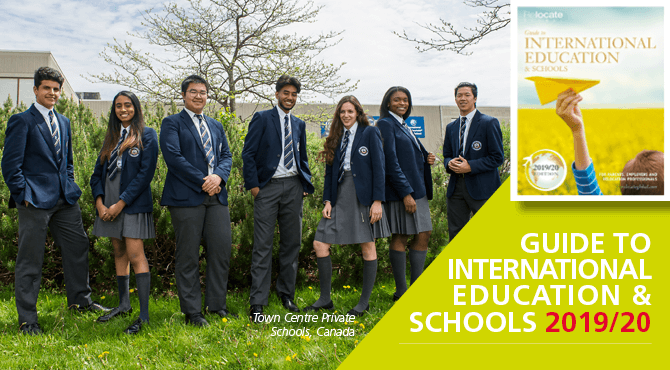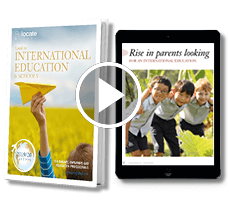Read the big print: choosing the right international school
As there is no standard international school system, parents seeking the best education for their children can be faced with a confusing range of variables. Author and cross-cultural consultant Dr Richard Pearce presents his tips on asking the right questions and understanding exactly what is on offer.
What schools offer
The biggest print is used for the name of the school. ‘British School of Lilliput’ is the clearest message of what is on offer, but what can we find out about ‘The International School of Brobdingnag’? To be sure, the name ‘international’ is a claim to be different from the national model, but of which nation, and how different? It is often the case that those running the schools have little awareness of these national values, which they themselves take for granted. The deep values in a school system are felt intuitively, and so, unfortunately, are the emotions with which newcomers react to unfamiliar experiences. The character of a school emerges from the curriculum, the teachers, and the student community. The choice of curriculum boils down to established national models, usually of either the US or England and Wales, perhaps enriched with the International Baccalaureate or International Primary or Middle Years curriculum.For example, in the expatriate growth centre of Dubai, where 185 private schools educate the whole expat community (and more than half the host community), 39 per cent of children follow the UK curriculum, 18 per cent the Indian, and 23 per cent the US. Due to the boom in demand, 120 more schools are expected to open by 2026.Increasingly, schools are being opened by big chains such as GEMS, Nord Anglia or Taaleem, which follow central policies. These are the non-governmental organisations of education, supranational education undertakings, but they invariably draw upon national models and traditions.
The character of a school emerges from the curriculum, the teachers, and the student community. The choice of curriculum boils down to established national models, usually of either the US or England and Wales, perhaps enriched with the International Baccalaureate or International Primary or Middle Years curriculum.For example, in the expatriate growth centre of Dubai, where 185 private schools educate the whole expat community (and more than half the host community), 39 per cent of children follow the UK curriculum, 18 per cent the Indian, and 23 per cent the US. Due to the boom in demand, 120 more schools are expected to open by 2026.Increasingly, schools are being opened by big chains such as GEMS, Nord Anglia or Taaleem, which follow central policies. These are the non-governmental organisations of education, supranational education undertakings, but they invariably draw upon national models and traditions.Signs of the systems
How can we see the difference if it isn’t in the name? Look at the terms used in the prospectus: are years named in UK or US terminology? Are the teachers qualified in the US, the UK, the host country, or around the English-speaking world? Do the biographies of the administrators quote distinguished service in home systems, long experience in this locality, or many postings around the globe? Look at the client community; in many areas, the student population may be up to 90 per cent from the host country.This is the group from which the child’s close friends – crucial social models at secondary age – will be drawn, whatever the curriculum and staff. Look at the programme (or ‘program’) and the target exams. If children are being prepared for more than one set of exams, what is the proportion? What are the main offerings among the after-school activities, and are they what you expected at home?Look at the ‘news’ section on the school’s website; what activities do they feel proud to advertise? The staff themselves may not understand the gulf between national norms as well as the experienced expat family does.There is often a well-intentioned ‘transition’ programme to induct newcomers, but children may not be rewarded for their efforts to be good in the way they have previously learned. Local conditions and local markets inevitably compel schools to compromise. All around the world, directors are trying to square circles, making their notion of the perfect school the local situation. Overseas branches are devised in the home country, based on a long reputation in a specific market, but they have to be developed in very different conditions – legally, socially, climatically and economically – abroad.Teachers also need to adjust when overseas. A good school will have a professional development programme for its teachers, which is worth examining. An overseas national school will fly out experts whose reputation has been built within the home country to keep teachers up to date with ‘best practice’ in the home system. However, there is no such thing as ‘international best practice’. A consciously international school will help teachers – and administrators – by giving cross-cultural training, to broaden their vision of the variety of needs and norms of the community they serve.Differences in values
This is a huge field, but let’s look at some key differences between the commonest choices, US and English schools. School values reflect national values. At primary level, the systems have more in common, but they diverge progressively with age. In principle, US education is democratic, tailored for the whole population. Final academic specialisation is delayed until the third year of university (which is often still referred to as ‘school’).Courses are aimed at the great majority of the population, and exams are there to confirm that the child has mastered the material. Scores for tests are therefore high, and failing means taking the course again, or at least getting no credit for it.European students, on the other hand, generally specialise in subjects while still at school, and are often divided into separate academic streams. Rigorous exams are used to make these judgments. Marks therefore cover a wide range, often below 70 per cent, and those with high marks get admission to specialised schools or courses. Curiously, the situation is reversed for sports, traditionally a whole-class activity in the UK but performed by a squad of selected enthusiasts in the US.Teachers in the US are generalists, qualified primarily for an age group, while in Europe they are more specialised in a subject. The US system encourages children to be confident, and to present their work in public; British schools, especially the overseas offshoots of the major public schools, belong to a tradition of more didactic teaching, with knowledge tested by external examinations at the end of the course.What parents expect
There are surprises for every family arriving in a foreign school, from many directions. Frequent pinch points in the newcomers’ experience are lunch arrangements, school buses, perceptions of what to expect from a fee-paying school, and the role of the parents in the school community, among many others.There will be local practical matters, imposed by the climate or the economic status of the expat in the host country, and there will also be novelties reflecting the British or American culture of the educational system. A wise policy is to seek local advice from friends, remembering that they are judging the school through their cultural eyes, taking much for granted. It is obvious to Brits that some children should be selected for a more intensive education than others through serious testing, and equally obvious to Americans that everyone has an equal right to the nation’s schooling and all deserve encouragement.How much can a child adapt to a strange system? It is impossible to generalise, but while primary children may have fewer clear expectations, at secondary age most Western children have firm ideas of what they like or don’t like. For them, first-time expatriation may be difficult.On the other hand, children who have grown up in a succession of expatriate communities may have learned flexibility along the way. True, they may not have the sense of a home locality that their parents grew up with, but that is not essential to life. There is, indeed, an emerging global business caste.Planning for the future
It is a good plan for parents to approach schools with a list of their particular priorities jotted down beforehand. Major concerns may be about getting access to the desired school back home, having a grounding in the subjects and topics that they value as a basic education, having a cultural mix, or experiencing the host country.How much of this will the school provide, and how much can you do yourselves? Is it, in extremis, better to stay at home? Very broadly, this may be a moment to choose between maximising the cultural consistency of home and school, or alternatively entering the global English-speaking ‘international’ community.One thing is certain: a child educated overseas will not be the same as one raised at home. There are currently over 258 million people now living outside their countries of their birth, with nine million Americans living overseas according to the US state department, while the figure for Britons living abroad is around five million. For the globally prepared child, the opportunities are limitless.This article is from Relocate Global's Guide to International Education & Schools 2019/20 which is packed with expert tips and information for those relocating and the professionals supporting them. For volume options, co-branded editions, digital or online licence agreements and advertising opportunities, contact Fiona Murchie at +44 (0)1892 891334 or email fiona@relocatemagazine.comNow available as an ebook on Amazon! Simply download from Amazon onto your Kindle, mobile phone or tablet to read wherever you are!
Subscribe to Relocate Extra, our monthly newsletter, to get all the latest international assignments and global mobility news.Relocate’s new Global Mobility Toolkit provides free information, practical advice and support for HR, global mobility managers and global teams operating overseas.
 Access hundreds of global services and suppliers in our Online Directory
Access hundreds of global services and suppliers in our Online Directory For more education and school-related news, visit our Education and Schools pages.© 2019. This article first appeared in the 2019/20 edition of the Guide to International Education & Schools published by Relocate Global, Spray Hill, Hastings Road, Lamberhurst, Kent TN3 8JB. All rights reserved. This publication (or any part thereof) may not be reproduced in any form without the prior written permission of Relocate Global. Relocate Global accepts no liability for the accuracy of the contents or any opinions expressed herein.
For more education and school-related news, visit our Education and Schools pages.© 2019. This article first appeared in the 2019/20 edition of the Guide to International Education & Schools published by Relocate Global, Spray Hill, Hastings Road, Lamberhurst, Kent TN3 8JB. All rights reserved. This publication (or any part thereof) may not be reproduced in any form without the prior written permission of Relocate Global. Relocate Global accepts no liability for the accuracy of the contents or any opinions expressed herein.































